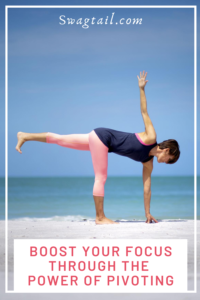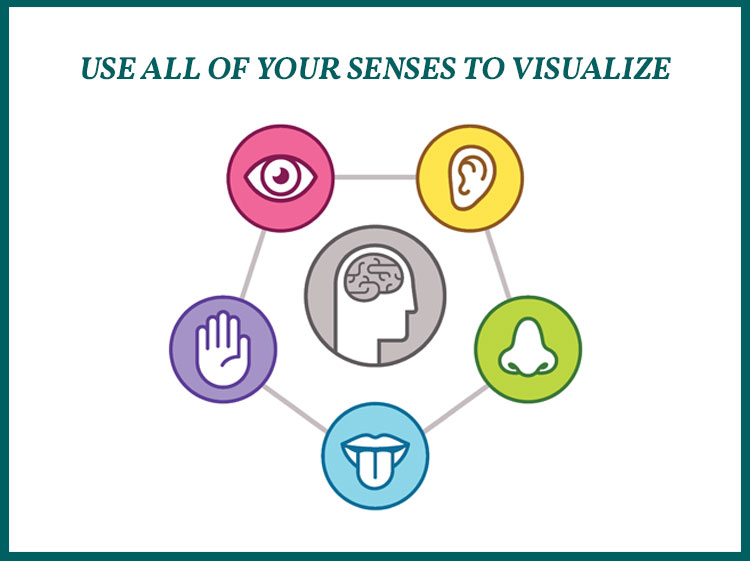 Focus is one of the most important skills you can master in life. Yet while you teach students to do this with each conscious breath and every meaningful dristi on the yoga mat, it can be easily forgotten in everyday circumstances. That’s why I use the PIVOT method to return your focus to the present moment. It helps you stay centered amidst contrast and stable in uncertain times. Plus, it increases the appreciation you have for yourself and the others with whom you interact on a regular basis.
Focus is one of the most important skills you can master in life. Yet while you teach students to do this with each conscious breath and every meaningful dristi on the yoga mat, it can be easily forgotten in everyday circumstances. That’s why I use the PIVOT method to return your focus to the present moment. It helps you stay centered amidst contrast and stable in uncertain times. Plus, it increases the appreciation you have for yourself and the others with whom you interact on a regular basis.
The PIVOT method began as an acronym I taught in my Flexible Golfer Program. The goal for my students was to increase their awareness just before taking a swing. It’s in those crucial moments just before hitting a ball that most golfers get distracted. This causes mis-hits, lost balls, and lots of frustration.
Yet I soon realized that the very same principles apply to all of us. For golfers, they want to boost focus before each new shot to increase success. In life, we all face new segments of our day in which we also want the same self-assuredness and productivity. We want to reach our goals. And focus is the tool that can help us achieve them.
So, here’s my take on the PIVOT method you can use (and teach your students) to find alignment in any given moment.
Photo Credit: Ember and Earth Photography
WHAT IS PIVOTING?
In order to understand why pivoting is important to boost your focus, you want to have clarity about what pivoting means. The word PIVOT has numerous meanings. In the literal sense, pivoting means to change position. On a yoga mat, you transition through various supine, seated, and standing poses during a yoga class. Off the mat, you assume numerous postures as well. You go from the position of cooking breakfast to driving across town to standing in line at the store.
Pivoting also refers to a change in direction. If you pivot, you shift your momentum from one target to another. This is really important in the mental game of golf because you want to shake off the unwanted events of the past so you can hit the ball well in the next. Or you might want to return to neutral after an amazing shot so you can do it again without doubt or uncertainty.
The same is true when approaching any pose on the yoga mat. It’s also relevant throughout the various circumstances of the day, right?
You want to remain emotionally calm so that you can make the best decisions possible. That’s why you can use the PIVOT method below to shift your momentum in the direction you desire.

Photo Credit: 4Max
WHEN TO PIVOT
In golf, I teach students to PIVOT during their pre-shot routine. That is the time before they step up to hit the ball. I also give specific verbal cues to yogis on the mat before we transition into a new pose. These are the preparatory moments that get you ready for what’s to come.
Thus, when you PIVOT during your day, you want to use this method any time you enter a new segment.
What’s a new segment?
Any time something changes. You could be cooking breakfast and in walks your 12-year-old daughter. That’s a new segment.
Or you could close your front door, and walk to your car. New segment. When you sit down in your vehicle and start the engine, that’s also a new segment.
Those are simple examples, but you might also want to pivot–or change direction–in more dramatic ways. COVID-19, for example, has shifted the way you teach yoga. Perhaps you lead more classes online than you do in person. That’s a time to PIVOT. Or, maybe you tried a marketing strategy and it’s not working. That’s also a time to pivot and switch tactics.
Basically, you have the opportunity to PIVOT at any moment. Yet you want to do so before you take action.
THE PIVOT METHOD
When you’re ready to start a new segment of your day or the broader aspects of your life, use the following acronym to remember the steps of the PIVOT method.
P = Pause
I = Intention
V = Visualization
O = Outbreath
T = Trust yourself
So let’s look at each of those elements in detail.
“P” STANDS FOR PAUSE
Pause is the first step of this method because it means you stop the momentum going in one direction. You stop, look around, and gain clarity in this pause from which to move forward again.
I often think about this when driving down the highway. If I need to take an exit, it’s a lot easier to make the turn if I anticipate the change and slow down first. On the contrary, if I stay at the 75-mph speed limit and try to turn abruptly, I’ll likely miss the exit entirely. Or, if I do, it will be very dangerous in doing so.
Since you are making a change in your life–big or small–it helps to slow down and pause for the transition.
Transitions on the Yoga Mat
Many yoga injuries occur not in the postures themselves, but in the transitions into and out of those poses. That’s why a pause before changing shapes is so important. Keep that in mind as you guide your students on the mat this week–and use those breaks as an opportunity to teach them to pause off of the mat, too.

Photo Credit: Yuttana Jaowattana
“I” IS FOR INTENTION
An intention is simply a clear thought about what you want to happen. That’s it. You can have a broad idea about what you want to occur at the beginning of your day. Or, you can have a very specific intention about the class theme you want to integrate into class. You can also have general and detailed goals for your future.
Setting an intention helps you focus in the pivoting process. In fact, you can ask yourself this one question to clarify your goal or desire:
“what would it be like if…?
By the very nature of the question, you are able to allow new insights and creative ideas to flow into this intention. You get ideas about how the new segment of your life might be different.
Try not to edit your responses. Likely they will come quickly, and give you insights about the situation. And with this information, you can make great choices about how to move forward.
Now it’s time to move on to the next element of the PIVOT process, which is to visualize your intention in motion.

Photo Credit: Ember and Earth Photography
“V” STANDS FOR VISUALIZATION
Visualization uses your imagination to create an experience in your mind. This is where you imagine your intention coming to life.
This is important because you have about 11 million sensory receptors in the body, and ten million of those are dedicated to the eyes alone. Yet the mind doesn’t know the difference between what is imagined with the eyes and what is actually seen with them.
Scientific research shows the same areas of the brain and body light up when you visualize something and when you actually experience it. This makes envisioning the perfect manifestation of your future so powerful!
Visualize your Intention
For this step, imagine the best outcomes possible. Or, tap into the reservoir of past knowledge by recalling a similar experience that turned out really well.
Then engage your eyes, ears, and kinesthetic wisdom to flesh out that intention with as much detail as possible. With practice, this won’t take long at all. And the good news is, that if you build in times to pause throughout your day, you can savor the moments of stillness in which to visualize your next steps.
After your visualization is complete, it’s time to move on to the next step.

“O” IS YOUR OUTBREATH
Yes, the “O” in PIVOT represents your outbreath. Yes, you’re familiar with pranayama and the four parts of the breath. You often cue your students to release one position on the exhale before transitioning into the next.
The same goes in the PIVOT method. You want to exhale before changing direction. You want to release the thoughts of the past. And you definitely want to leave behind any physical tension and trust your body is capable of executing your intention.
Just as many golfers mis-hit their golf shots because of mental or physical strain, you can fail to realize your goals because of unwanted stress.
When you take a purposeful outbreath, you signal to your mind that it’s time to chill out. Your body knows that to do and a deep breath out reinforces that you’re ready to trust your higher self to guide you into the best experiences possible.
Tips to Increase focus with your Outbreath
There are many ways you can expel the breath from the lungs.. Yet try these tips to get your mind and body aligned before you take action in your day:
- Take a deep exhale through the mouth.
- Try to breathe slower, and elongate the exhale/
- Complete the entire breath out before moving. This is true whether you’re just about to share your thoughts with others or start your car or make a change in careers.
It can be tempting to rush this step and move forward before the breath is completely released.
Then, see if you can rest in the pause before your breath comes in again. It’s a subtle, but powerful mental trigger that you are strong and capable and ready to embrace the unknown.

Photo Credit: Maridav
“T” IS FOR TRUST
This last part of the PIVOT method is about trusting yourself. Yes, you want to confidently know that the words you’re about to speak or the actions you’re about to take are in your best and highest good.
Problems often arise when you overthink the process or lose focus on what’s really important in the moment.
The previous steps in this PIVOT process are designed to prevent that from happening. The pause gives you immediate feedback to make nuanced changes in your life. Then, your intention then clarifies the mind and the visualization brings all of your senses in alignment with your desire. The outbreath is the final reminder that you’ve got this.
Because you’ve done the work in the previous steps to come into personal alignment, it’s now time to move. You just want to have a higher level of faith as you do.
PUTTING IT TOGETHER
As James Clear says, “You do not rise to the level of your goals. You fall to the level of your systems.” You can elevate your time on the yoga mat and your quality of life as a whole with greater mental focus. And the PIVOT method is the system you use to train the mind over and over again for success.
Take Action Now:
- Download this PIVOT worksheet and refine your own approach to changes in your life today.
- Use the PIVOT method at least once a day this week. Pick one area of your day where you could consciously bring more attention to the moment, and observe what changes occur as a result.
- Test your newfound mental skills in larger areas. Make notes about areas of your life that are working, and which ones could use some adjustment. Then, decide in which ways you might apply the PIVOT method for these life shifts as well.













Leave A Comment